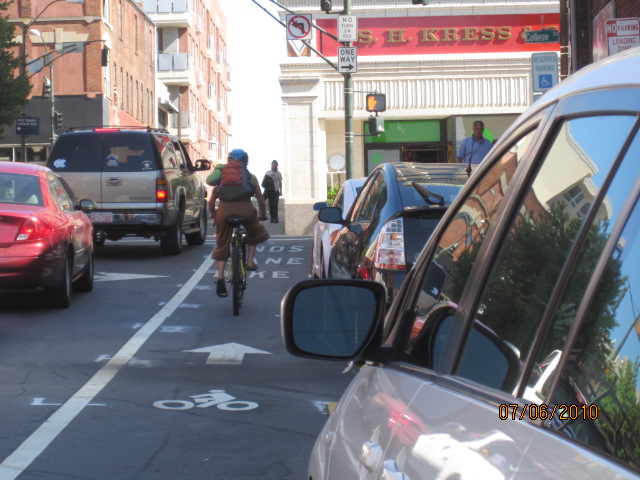Asheville, we have a problem. Recent studies indicate that the city – eco-friendly, carbon-cutting Asheville – is the most dangerous city per capita for pedestrians in all of North Carolina. Cyclists here do not fare much better.
How did this problem develop and what can be done to resolve it? The Asheville Green Drinks group converged on the Green Sage Café on Wednesday night, July 2, to discuss the city’s multimodal crisis. Featured speakers were multimodal advocate Tom Burnett, transportation planner Don Kostelec, and Multimodal Transportation Commission Chair Jim Grode.
Tom Burnett – hydrologist by day, transportation activist by night – opened the forum with a presentation of data collected at a recent “hackathon” that focused on multimodal transportation. By plotting reported accidents on a map, Burnett was able to show that downtown Asheville – especially the area surrounding the intersection of Patton Avenue and College Street – was a hotspot for accidents between pedestrians and bicyclists and motorists. Other danger zones included Tunnel Road in East Asheville, Haywood Road in West Asheville, Merrimon Avenue in North Asheville, and McDowell Street heading toward South Asheville.
The common theme: More traffic and more people mean more multimodal accidents. As Burnett also pointed out, the incidence of multimodal accidents is increasing as the economy stabilizes and Asheville’s tourism industry resurges.
While the problem seems apparent, the solution is more elusive.
“It’s going to take a lot of different things to make this better,” Burnett said.
Don Kostelec, a transportation planner, said that an “institutional bias” underlies the multimodal problem. Having titled one section of his presentation “How to Get Away with Murder on North Carolina’s Roads,” Kostelec emphasized the law’s unequal treatment of motorists versus pedestrians and cyclists. Drivers in North Carolina are seldom charged in multimodal accidents, he noted.
Kostelec went on to explain that law enforcement and the media tended to dehumanize multimodal accidents and shift blame away from drivers. As examples, he cited police reports and newspaper articles that described accidents in terms of a vehicle (rather than the driver of that vehicle) hitting a bicycle (rather than the bicyclist).
Municipal bodies also favor motorists, according to Kostelec. He pointed out instances in which pedestrians had no alternative but to walk on the side of the road, demonstrated the unfairness of expecting pedestrians to make lengthy detours in order to reach approved crosswalks, and showed how construction zones gave ample warning to drivers but forced pedestrians and cyclists into dangerous traffic.
When he was asked what could be done to remedy the multimodal bias, Kostelec said, “Be vigilant; speak up; and don’t be afraid to needle.”
He advocated opening dialogues with the North Carolina Department of Transportation, Asheville City Council, and local law enforcement. Kostelec also praised projects such as the “Pedestrian Walk” and the “Stop Sign Olympics.”
The term “tactical urbanism” surfaced briefly. This concept refers to a sort of vigilante approach to community improvement in which citizens — frustrated with unresponsive municipalities — take matters into their own hands. Kostelec mentioned an instance (not in Asheville) in which a group of citizens painted their own bike lane on a bridge after their appeals for the city to do so were ignored.
“I’m not encouraging it, but there’s guidance out there,” Kostelec said, grinning and suggesting a Google search.
While Kostelec discussed what individuals could do, Jim Grode talked about what the city of Asheville is doing to improve the multimodal problem. For starters, he cited increased spending in the multimodal portion of Asheville’s capital improvement budget, approved last month. While slightly less than $1.5 million was devoted to multimodal improvements in 2008, Brode projected that more than $8.5 million would be spent on multimodal projects in 2014. Brode also referenced recent multimodal construction that included 10 miles of bike lanes, five miles of sharrows, five miles of greenways, and 15 miles of sidewalks.
Nevertheless, Brode said, issues remained. Superimposing a map of multimodal construction on a map of multimodal accidents, he showed that the improvements being made did not always correspond to the areas in which they were most needed.
But Asheville’s citizens can make a difference.
“We are just about to be embarking on a new multimodal spending plan,” Brode said. “There will be multiple opportunities for public comment and public participation.”
Brode also recommended talking to members of City Council on an individual basis and encouraging them to prioritize multimodal transportation spending.
“When we do this plan, participate in the plan,” he said.
— by Erik Peake




Before you comment
The comments section is here to provide a platform for civil dialogue on the issues we face together as a local community. Xpress is committed to offering this platform for all voices, but when the tone of the discussion gets nasty or strays off topic, we believe many people choose not to participate. Xpress editors are determined to moderate comments to ensure a constructive interchange is maintained. All comments judged not to be in keeping with the spirit of civil discourse will be removed and repeat violators will be banned. See here for our terms of service. Thank you for being part of this effort to promote respectful discussion.